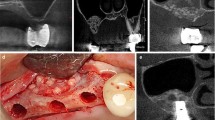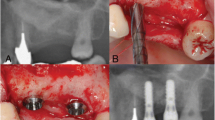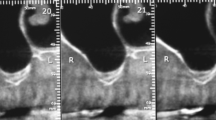Abstract
Background
Phycogene hydroxyapatite is a biological hydroxyapatite derived from calcifying maritime algae, and is prepared by hydrothermal conversion by pyrolitical segmentation of the calcium carbonate of native algae into fluorhydroxyapatite. The aim of the present study was a histological and histomorphometrical evaluation, in humans, of specimens retrieved from sinuses augmented with phycogene hydroxyapatite, after a healing period of 6 months.
Case series
Ten healthy patients with noncontributory past medical history (four women and six men, all nonsmokers, mean age 59 years, range 54–65 years) were included in this study. All patients were candidates for augmentation in the posterior maxilla in order to receive fixed restorations. The maxillary sinuses were filled with phycogene hydroxyapatite (Algipore®, Dentsply Friadent, Mannheim, Germany). Twenty-three implants (XiVE®, Dentsply Friadent, Mannheim, Germany) were placed in the augmented sinuses after a healing period of about 6 months. The bone cores were retrieved and were processed for histology. Most particles of phycogene hydroxyapatite were surrounded by a mineralized tissue, and the biomaterial particles had served as an osteoconductive scaffold. Most particles were bridged by newly formed bone characterized by the presence of large osteocytic lacunae, also around the phycogene hydroxyapatite particles, which appeared to be partially resorbed and substituted by new bone. No inflammatory cells or foreign body reaction cells were present around the biomaterial. No gaps were present at the bone–particle interface, and the bone was always in close contact with the particles. Histomorphometry showed that the percentage of newly formed bone was 35.2 ± 3.6%, marrow spaces 35.6 ± 2.3%, and residual grafted material 37.1 ± 3.8%.
Discussion
In conclusion, the present results support the literature findings that phycogene hydroxyapatite can be used, successfully, for sinus augmentation procedures.







Similar content being viewed by others
References
Thorwarth M, Wehrhan F, Srour S et al (2007) Evaluation of substitutes for bone: comparison of microradiographic and histological assessments. Br J Oral Maxillofac Surg 45:41–47
Simunek A, Cierny M, Kopecka D, Kohout A, Bukac J, Vahalova D (2005) The sinus lift with phycogenic bone substitute. A histomorphometric study. Clin Oral Impl Res 16:342–348
Ewers R, Goridowa W, Schopper C, Moser D, Spassova E (2004) Histologic findings at augmented bone areas supplied with two different bone substitute materials combined with sinus floor lifting. Report of one case. Clin Oral Impl Res 15:96–100
Schopper C, Moser D, Sabbas A et al (2003) The fluorohydroxyapatite (FHA) FRIOS® ALGIPORE® is a suitable material for the reconstruction of severely atrophic human maxillae. Clin Oral Impl Res 14:743–749
Klongnoi B, Rupprecht S, Kessler P et al (2006) Lack of beneficial effects of platelet-rich plasma on sinus augmentation using a fluorohydroxyapatite or autogenous bone: an explorative study. J Clin Periodontol 33:500–509
Ewers R (2005) Maxilla sinus grafting with marine algae derived bone forming material: a clinical report of long-term results. J Oral Maxillofac Surg 63:1712–1723
Turhani D, Weissenbock M, Watzinger E et al (2005) In vitro study of adherent mandibular osteoblast-like cells on carrier materials. Int J Oral Maxillofac Surg 34:543–550
Turhani D, Cvikl B, Watzinger E et al (2005) In vitro growth and differentiation of osteoblast-like cells on hydroxyapatite ceramic granule calcified from red algae. J Oral Maxillofac Surg 63:793–799
Turhani D, Watzinger E, Weissenbock M et al (2005) Analysis of cell-seeded 3-dimensional bone constructs manufactured in vitro with hydroxyapatite granules obtained from red algae. J Oral Maxillofac Surg 63:673–681
Roos-Jansacker AM, Renvert H, Lindahl C, Renvert S (2007) Submerged healing following surgical treatment of peri-implantitis: a case series. J Clin Periodontol 34:723–727
Roos-Jansacker AM, Renvert H, Lindahl C, Renvert S (2007) Surgical treatment of peri-implantitis using a bone substitute with or without a resorbable membrane. J Clin Periodontol 34:625–632
Piattelli A, Scarano A, Quaranta M (1997) High-precision, cost-effective system for producing thin sections of oral tissues containing dental implants. Biomaterials 18:577–579
Hutmacher DW (2000) Scaffolds in tissue engineering bone and cartilage. Biomaterials 21:2529–2543
Jones AC, Arns CH, Hutmacher DW, Milthorpe BK, Sheppard AP, Knackstedt MA (2009) The correlation of pore morphology, interconnectivity and physical properties of 3D ceramic scaffolds with bone ingrowth. Biomaterials 30:1440–1451
Schopper C, Moser D, Wanschitz F et al (1999) Histomorphologic findings on human bone samples six months after bone augmentation of the maxillary sinus with Algipore. J Long Term Eff Med Implants 9:203–213
Acknowledgments
The work was partially supported by the Ministry of Education, University and Research (M.I.U.R.), Rome, Italy.
Author information
Authors and Affiliations
Corresponding author
Rights and permissions
About this article
Cite this article
Scarano, A., Degidi, M., Perrotti, V. et al. Sinus augmentation with phycogene hydroxyapatite: histological and histomorphometrical results after 6 months in humans. A case series. Oral Maxillofac Surg 16, 41–45 (2012). https://doi.org/10.1007/s10006-011-0296-3
Received:
Accepted:
Published:
Issue Date:
DOI: https://doi.org/10.1007/s10006-011-0296-3




